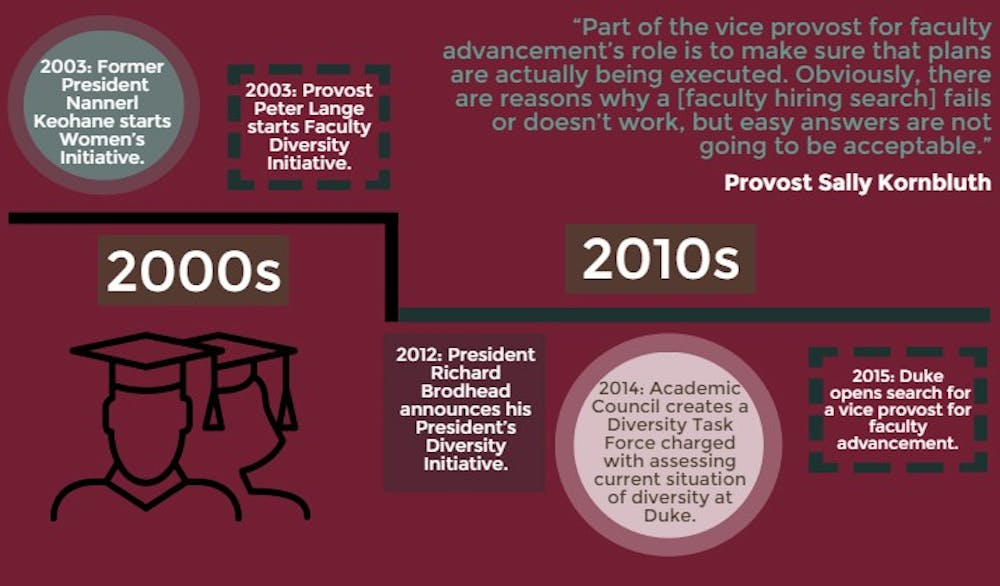In response to student concerns about lack of faculty diversity at Duke, the University has opened a search for a vice provost for faculty advancement.
Provost Sally Kornbluth announced the search for the new vice provost, whose main responsibility will be promoting “diversity and inclusion” on campus, in a community conversation Nov. 13. A faculty report on diversity released in May found that the percentage of non-White faculty remains low, but has seen a modest increase in the past decade—the percentage of Black faculty increased from 3.8 percent to 4.4 percent, and the percentage of Hispanic faculty from 1.8 percent to 2.6 percent.
The 53-page report noted that the University’s success in hiring female and black professors has been uneven, and its percentages of female and Hispanic professors are lower than at other schools ranked in the top 20. The report called for increased diversity in faculty searches and the creation of an inclusive environment for retention.
Kornbluth explained in a Nov. 19 Academic Council meeting that the new provost will be responsible for ensuring plans to improve diversity are executed.
“Obviously, there are reasons why a [faculty hiring search] fails or doesn’t work, but easy answers are not going to be acceptable,” Kornbluth said.
Some faculty members noted that multiple factors may be the cause of lack of faculty diversity.
“[Faculty hiring] is a very complicated issue,” said Amy Anderson, instructor in the Program in Education. “For example, in the education program here at Duke, there is no tenure track, but only Professors of the Practice and instructors, and that leads to some challenges in diverse hiring.’’
She explained that the lack of tenure track in the Program in Education causes less security among faculty, so it is possible that a potential Black faculty candidate might be attracted to other institutions that offer tenure track in their programs of education.
“It’s great that they are announcing this new position as long as it’s not lip service,” Anderson said. “An institution has to identify its goals and put resources towards that direction.”
The announcement of the new position is the latest in a series of administrative efforts to improve diversity. Early efforts to improve faculty diversity focused specifically on Black faculty—notably through the Black Faculty Strategic Initiative, which doubled the number of Black faculty at Duke in the 10-year span from 1993 to 2003.
Duke continued its effort through former President Nannerl Keohane’s Women’s Initiative in 2003 and Provost Peter Lange’s 2003 Faculty Diversity Initiative. More recently, President Richard Brodhead announced his President’s Diversity Initiative in 2012, requesting that each senior administrator set three goals each academic year and report back on the progress.
The faculty report released in May after 14 months of study found that despite these efforts, percentages of Black, Hispanic and female faculty are low.
With the national spotlight focused on race relations at schools across the country, increased attention is being paid to the importance of faculty diversity.
At Yale University, a five-year, $50 million initiative aimed at increasing faculty diversity was launched in early November—following a campus-wide call to increase faculty diversity in October and protests following a faculty member’s comments about offensive Halloween costumes. The funding will support half the salary of any hired candidate who brings diversity to a department.
“Yale recognizes the danger of investing only in the talents of a narrow slice of society and is committed to investing funding and human capacity that is necessary to the success of this initiative,” Karen Anderson, Yale’s associate provost for academic resources and faculty development, wrote in an email.
However, according to the Yale Daily News, students and faculty members noted that the lack of faculty diversity goes beyond hiring. The low number of minorities in the pool of prospective professors and the university’s inability to retain faculty of color all contribute to the problem.
Statistics on faculty at Yale and the University of Missouri, which has also been a scene of race-related protests, also indicate low levels of faculty diversity.
A faculty head count performed in fall 2013 showed that 2.8 percent of Yale faculty members are Hispanic, 3.5 percent are African American and 9 percent are Asian. Missouri, on the other hand, reported 3.25 percent Black/African American faculty and 3.12 percent Hispanic/Latino faculty as of Fall 2014.
Amid the controversy surrounding student protestors at Missouri, a Chancellor’s Diversity Initiative has been launched, and the university is having a national search for a new vice chancellor for inclusion, diversity and equity.
Editor’s note: The terms used to describe ethnicity in this story correspond to the terms used in the reports referenced.
Get The Chronicle straight to your inbox
Signup for our weekly newsletter. Cancel at any time.

